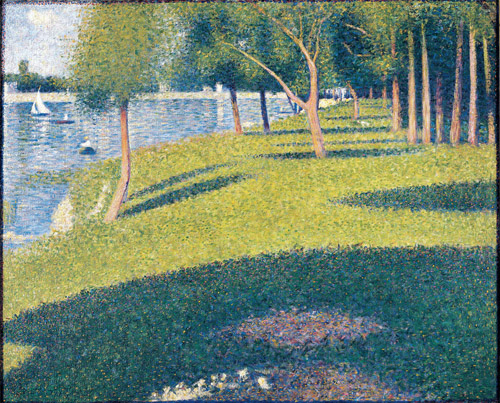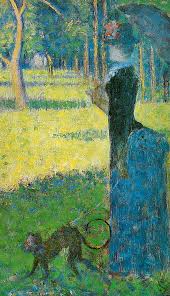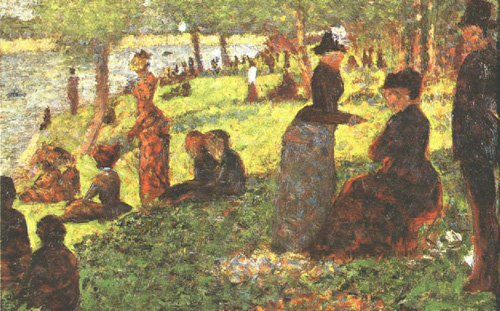Sven Loevgren, The Genesis of Modernism
Georges Seurat's A Sunday Afternoon on the Island of La Grand Jatte
A walk along the Boulevard Bineau towards Neuilly leads straight to the island of La Grande Jatte in the Seine. The island, as its name implies, has a bowl-like depression in the middle. It is surrounded by a low, but rather steep beach. Today most of the island is covered with ugly heaps of coal and blackened stumps of trees. In the 1880's, however, it was a pastoral, idyllic place and a popular recreation spot within easy reach of Paris.
In the middle of the eighties one of Georges Seurat's friends, Maurice Beaubourg, kept his canoe on the island. For some time canoeing had been a popular sport, as is shown by a large number of impressionist paintings. Beaubourg relates that Sundays on La Grande Jatte were very lively. Vociferous canoeists and soldiers congregated there to drink beer and eat waffles, which were made on portable stoves. The island seems also to have served as a modern Cythera, a rendezvous for the burghers of Paris and the city cocottes.1
This was the milieu that Georges Seurat chose to describe in his picture Un dimanche après- midi à l'île de la Grande Jatte (Fig. 8). He commenced work on the painting in the autumn of 1884, and continued until March 1885. Then followed a break during which Seurat was painting at the seaside, at Grandcamp. On his return to Paris in October he resumed work on the picture, which was completed in time for the last "Impressionist Exhibition" at the Maison Doré.
A large number of drawings and sketches in oil --executed on the spot--preceded and were made side by side with the picture, which was wholly composed and completed in the studio. . . . Details of color and form, studies of light and shade were collected painstakingly to be finally brought together in a composition with the greatest possible expressive power. The monumental painting is executed in béjoité, the pointillist technique that made the work such a succès de scandale with the general public. With rigorous consistency Seurat applied the findings of experimental psychology in regard to the significance of complementary colors in the creation of the maximum intensity of light. Discussion of the technical novelties in La Grande Jatte has gone on ever since the work was first exhibited, right up to the present time,3 with such intensity and wealth of detail that the structural elements of the work, which are no less important, have been neglected. The composition presented by Seurat is in its entirety extremely individual.
The preliminary studies consist of about a score of drawings, some of them obviously made on the spot, others in the studio. To these must be added almost thirty paintings, most of them small, painted rapidly on the spot. A few larger, more thoroughly worked our sketches were executed in the studio. This method of work , which was opposed to that of the impressionists, naturally imposed its special character on the final composition. . . .
The forms created by Seurat in his charcoal drawings for La Grande Jatte have an extremely individual stamp. Seurat does not define forms with the help of distinct lines (in contrast to Ingres, whom he admired), but by rich contrasts of light and shade. One should not, however, assume therefore that the drawings--with
certain exceptions--are influenced by impressionism. On the contrary the distinction between figures and background is usually clearly stressed. This is attained by making the figures and the background equivalent in their capacities as contrasts; they have an analogous technical structure.
Seurat's drawings are strongly reminiscent of photographic negatives. It is uncertain whether the artist was influenced by photography, but it seems not unlikely. There is no doubt that by his style of drawing Seurat endeavored to attain a carefully calculated effect.The drawings give a strong feeling of dream and illusion, a feeling that is augmented by the tranquility and firm stability that characterize the figures. Here Seurat gives a view of the world in which the objective realities are changed to a strongly subjective, contemplative picture with marked aesthetic aims. . . .
For some other paintings by Seurat, the final version of La Grande Jatte, and some rather interesting more recent versions click here.
Studies for Seurat's Sunday Afternoon on the Island of La Grande Jatte (1884-1886)



